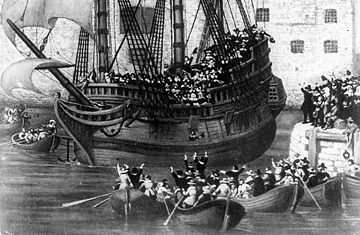
When Mr. and Mrs. George Fry set sail from England and arrived in Weymouth, Mass., in the 1630s, they brought to America more than just luggage and four kids. They also brought the original gene mutation that leads to a hereditary form of colon cancer — and has resulted in thousands of people in the United States today who are at higher risk of developing the disease.
The Fry family's mutation causes a relatively rare syndrome known as attenuated familial adenomatous polyposis (AFAP). Without proper clinical care, people with AFAP — who account for less than 1% of the 153,000 colorectal cancer cases in the U.S. every year — have a greater than two-in-three risk of developing cancer, compared with a one-in-24 chance in the general population. People with AFAP can begin develop colon polyps by their late teens (about 50% develop polyps in teenhood; others, later in life), and people with particularly severe cases are often advised to undergo a colectomy. Though colon cancer typically shows up in people over 50, in the Fry family, it has been observed as early as 26.
Using a genetic fingerprint, researchers at the University of Utah's Huntsman Cancer Institute tracked the founder genetic mutation — a mutation that has been traced from many individuals in the present-day population to a common ancestor — back to the Frys. The Fry mutation has not been found in other places that researchers have looked — not in England, Denmark or Germany — further confirming that the mutation started with the Fry immigrants. (The researchers believe the genetic change either originated with George Fry or his wife, or that it began with a Fry in England, who died before passing it further.) "These mutations all start somewhere, most of them are neutral, some are beneficial, occasionally you get one that is harmful," says Deb Neklason, lead researcher of the study, published this month in the journal Clinical Gastroenterology and Hepatology.
The researchers studied two large families, one in Utah and the other in New York, both carrying the same genetic mutation. It was a true "Aha!" moment, says Neklason, when she linked the two families to a common ancestor. "I tried to connect them years ago anticipating that they would come together in the 1700s," she says. "I was amazed that they went further back, and thrilled with the impact of this finding." There is a 15-generation span between George Fry and his wife and the Fry ancestors today.
Relying on data from the Utah Population Database (UPDB), a genetics goldmine that combines Mormon genealogy records with vital statistics and cancer records, researchers were able to identify many of the Fry descendants. The UPDB has records on 6 million people dating back to those born in the 1700s — the most extensive genealogical resource in the world. "The only place comparable would be Iceland, but they only have some 250,000 people countrywide," says Geraldine Mineau, who oversees the database.
The Utah branch of the Fry family began when a Mormon pioneer couple arrived in the state in the 1840s. Today there are more than 7,000 Fry descendants in Utah, spanning nine generations. The researchers tracked down more than 1,000 of the Utah Frys and identified 220 with the genetic mutation (according to the lineage, the other 6,000 members of the clan are not believed to have inherited the mutation), who accounted for 0.15% of all colorectal cancers reported in the state from 1966 to 1995. Based on that percentage, researchers expected to see eight cases of colon cancer from this family in the past 10 years. But because of early medical intervention after the founder mutation was identified in 1993, only one colon cancer diagnosis was made.
The New York branch of the family began two generations after the Utah Frys — the founding parents of the East Coast arm having been born just as the Frys' Utah pioneers were settling in the West. So far, researchers have studied some 200 of the Fry family's New York descendants and identified about 50 with the genetic mutation. Family members actually have a very low risk of inheriting the genetic mutation — about 1 in 8,000 — but those who do have it run a 69% risk of developing colon cancer by age 80, if they don't seek proper clinical care.
Neklason says that her study underscores the importance of knowing one's family history, being vigilant about health and, if necessary, getting a genetic test. About 5% of colon cancers are known to be hereditary, and another 25% have some familial, or genetic, component that researchers have not yet pinpointed (the majority of colon cancers, however, are linked to environmental and lifestyle factors, such as diet and smoking). If you have had 10 or more polyps, then you should consider genetic testing; if a genetic mutation is identified, your relatives should also be tested. If your family lineage links to the Frys, don't panic. Your risk of inheriting the cancer mutation is low, but if anyone in your immediate family has developed pre-cancerous polyps, it might be worthwhile to pursue genetic testing. As for routine screening, people with a family history of colon cancer should get colonoscopies staring 10 years prior to the youngest case of colon cancer in the family. For the general population, doctors recommend a colonoscopy starting at age 50 and every 5 to 10 years thereafter.
Neklason and her colleagues are still hunting down other people who have inherited a genetic risk. So far, the researchers have identified 13 other families in the U.S. who have the same genetic fingerprint and founder mutation and are all related. "We think those other 13 families out there link in at some point and we predict that there are hundreds of families out there who carry this genetic risk," says Neklason.
